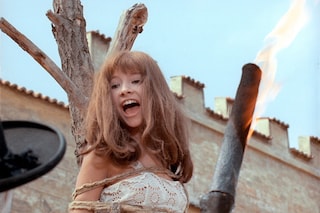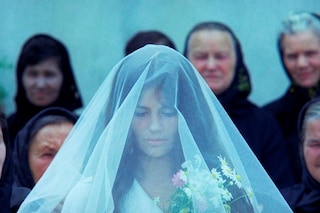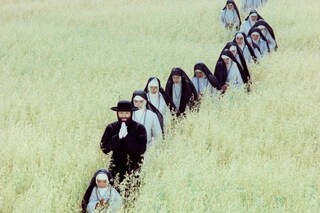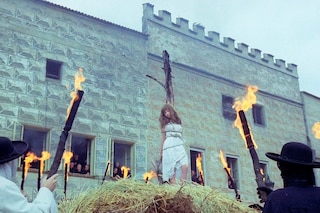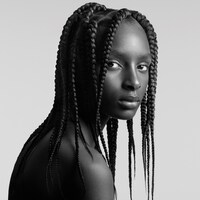Absurdity, surrealism and lush eroticism come together in Valerie And Her Week Of Wonders, with predatory men morphing into folkloric monsters after 13-year-old Valerie starts her period
In Jarom Jireš’ Czech new wave classic Valerie and Her Week of Wonders (1970), men mutate into grotesque fairy tale figures with faces and bodies as unnatural as their appetites at the first sign of (menstrual) blood. Fake teeth, white face paint and blue eyeshadow tell the story.
The plot of this erotic-horror coming-of-age fantasy revolves around Valerie, an inquisitive 13-year-old orphan who lives with her grandmother in a deeply religious rural village in Czechoslovakia. Here, pastel-lidded brunette virgins walk the streets, eyes cast down to avoid the sight of barefaced blonde harlots frolicking in rivers, rubbing fish on their naked breasts and fornicating in public.
The film is a relic of Czech new-wave cinema, a movement that emerged in the 1960s as Stalin and socialism’s grip on Czechoslovakia waned. It was a period of transition from propagandistic socialist realism to cinema rich in absurdity, surrealism and lush eroticism. Valerie, with its bold young protagonist and predatory corrupt authorities, has been praised as a rebuke of the 1968 revival of socialist realism mandates.
Many things are uncertain in Valerie, but one thing is clear: Valerie has her period. From the first drop of blood on a crisp white daisy, a world of sexual hypocrisy yawns wide and tries to swallow her up. In response, she imposes a child’s logic onto her new-found lascivious antagonists, transforming them into the villains of European fairy tales; werewolves, vampires and impish tricksters. Prolific make-up artist of the Czech new wave, Ladislav Bacíllek, draws on the iconography of European and Czech folklore to render heterosexual erotic scripts absurd. From the moment Valerie declares herself “not a child” to her stern grandmother, local male authorities are transformed into lecherous incubi.
For the looks, Bacíllek draws on the image of the “liška”, the untrustworthy fox, a figure of cunning in Czechoslovakian folklore. Male predators reveal themselves with a flash of glossy yellow-brown canines and fox-ish red hair signals duplicity throughout the film. There’s the omnipotent Constable, a sometimes priest and frequent shapeshifter who flaunts pointed, filthy teeth and vampiric white stage make-up so thick it looks like papier mâché. He persistently tries to deceive Valerie by mimicking her missing father, a young red-headed man.
Meanwhile, Valerie’s friend Eagle is her gentle guide, but his desire to help her is often overwhelmed by his desire for her. Occasionally his impish mask slips and he bares the same glistening canines of the men he tries to protect her from, wiry red sideburns sprouting from beneath his porkpie hat (a sartorial red flag all young women should learn).
Valerie’s greatest betrayal comes from her grandmother Babicka, played by 34-year-old Helena Anyzova. Babicka is a ghostly, waxen figure with greenish-white foundation, greige contouring, and a straw-like blonde wig. Seemingly hypnotised by Valerie’s menstruation, Babicka desperately propositions her granddaughter's suitors only to be rejected: she is grotesquely old. Tormented by her cravings she trades Valerie’s inheritance to the Constable for youth and sexual relevance. Selling out her granddaughter proves better than Botox.
Valerie, meanwhile, is not transformed by the desire of men. She preserves her soft matte skin and powder blue eyeshadow; the consistency of her beauty an aesthetically-coded rebellion against sexual awakening narratives that require female children to come of age so early. While cinema has long associated blue eye make-up with subversive and sexualised heroines, Valerie’s eggshell blue lids don’t cast her as a manic pixie dream girl or seductress. They tell us she’s a very ordinary girl. Meanwhile, male desire, viewed through the eyes of a child, becomes a monstrous spectacle.
Valerie’s suitors don’t like the scrutiny and try to have her burnt as a witch. She escapes without a hair out of place. While Valerie ends the film with a slightly more knowing look in her eye, her girlish world remains unchanged.

